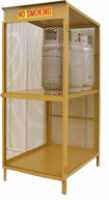 |
 |
| MSDS Topics |
Free Sites | FAQ's | Regulations | Glossary | Software | Suppliers |
| Books | Forum | Poll | Fun stuff | Quiz | Store | |
| MSDS and safety supplies | Search ALL our MSDS info | |||||
 | |||
 |
 |
 |
|
| Title: 05/23/2008 - Storage and use of compressed gas cylinders; whether cylinder is considered an oxidizing compressed gas or oxygen cylinder. | |
| Record Type: Interpretation | Standard Number: 1910.101, 1910.101(a), 1910.101(b), 1910.1200, 1910.1450 |
Mr. Charles Tricomi
Consolidated Edison of New York
31-01 20th Ave. Bldg. 136 2nd Fl.
Astoria, NY 11105
Dear Mr. Tricomi:
Thank you for your letter of September 18, 2007, to the Occupational Safety and Health Administration's (OSHA's) Directorate of Enforcement Programs (DEP). You had questions concerning standards applicable to the storage and use of compressed gas cylinders. Your paraphrased questions and our response follow.
Scenario: I have two compressed cylinders used for laboratory calibration of gas detectors. One cylinder contains 20.9% oxygen (balance nitrogen); the other contains 100% methane. The volume of each cylinder is approximately 2 cubic feet, and they are pressured at 2000 psi.
Question #1: What standards apply to the use, storage, and handling of these cylinders?
|
The standard further states, in §1910.101(b), that "the in-plant handling, storage, and utilization of all compressed gases in cylinders...shall be in accordance with Compressed Gas Association (CGA) Pamphlet P-1-1965." We note that there are more recent versions of the industry consensus standards that are referenced in §1910.101.2 If the more recent consensus standards address hazards associated with compressed gases that are not addressed in the CGA pamphlets referenced in the standard, §1910.101, §1910.1200, or any other applicable OSHA standard, the more recent consensus standards may provide support for a citation alleging a violation of the OSH Act's general duty clause, 29 USC 651(a)(1). If an employer is not in compliance with the requirements of an OSHA standard but is complying with the requirements of a current consensus standard that clearly provides equal or greater employee protection, the violation of OSHA's requirement will be treated as a de minimis violation. De minimis violations are those having no direct or immediate relationship to safety and health and result in no citation, penalty, or requirement to abate.
|  Get gas cylinder accessories such as tags, signs, and storage cabinets at Safety Emporium. |
Sincerely,
Richard E. Fairfax, Director
Directorate of Enforcement Programs
|
1 The standard, at §1910.101(a), requires the visual inspections to be conducted in accordance with the Hazardous Materials Regulations of the Department of Transportation (DOT) (49 CFR parts 171-179 and 14 CFR part 103), where appropriate. If these standards are not applicable, the standard requires that "visual and other inspections shall be conducted in accordance with Compressed Gas Association pamphlets C-6-1968 and C-8-1962..." [ back to text ] 2 CGA Pamphlets C-6-2007, Standards for Visual Inspection of Steel Compressed Gas Cylinders; C-8-2005, Standard for Requalification of DOT-3HT, CTC-3HT, and TC-3HTM Seamless Steel Cylinders; and P-1-2006, Safe Handling of Compressed Gases in Containers.[ back to text ] 3 CGA Specification G-7.1-2004, Commodity Specification for Air, indicates that compressed air is a blend of oxygen (ranging from 19% to 23%) and nitrogen (balance of the volume), and, in some cases, other trace gases.[ back to text ] |  Gas cylinder storage cabinets and more are available from Safety Emporium. |
The official, public domain, OSHA version of this document is available at http://www.osha.gov/pls/oshaweb/owadisp.show_document?p_table=INTERPRETATIONS&p_id=27277&p_text_version=FALSE